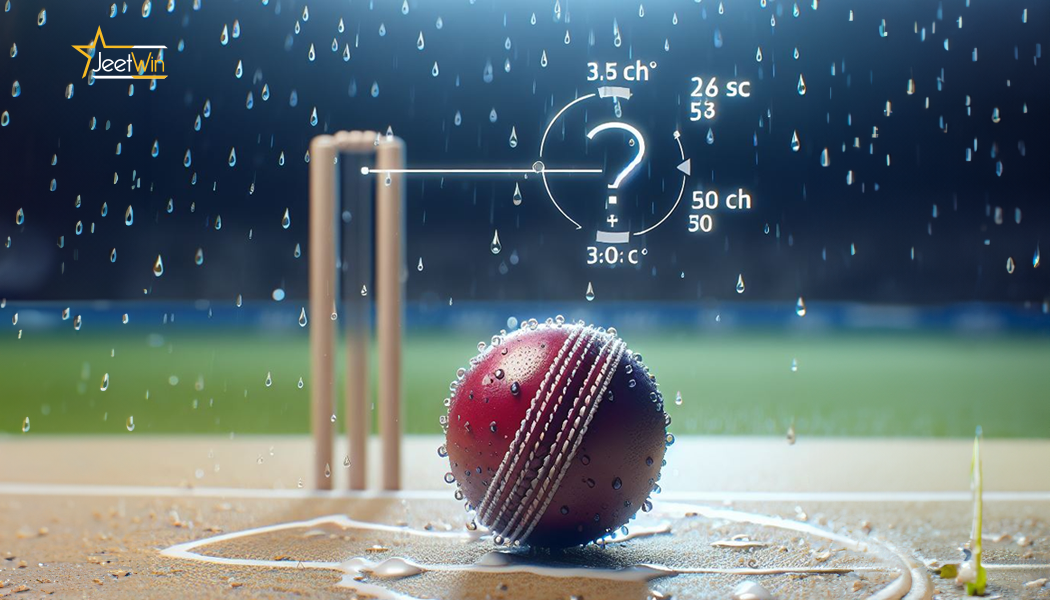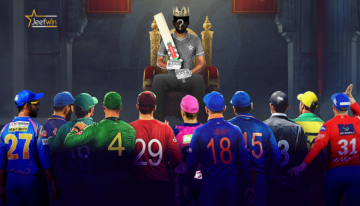
Weather or other disruptions can disturb any cricket games, interfering with the planned cricket strategies of any team. When it happens, it messes up the limited-overs match, turning into incomplete innings that can lead to unclear game outcomes. This is where the Duckworth-Lewis-Stern (DLS) method walks in, appearing as a mathematical solution to ensure a fair and calculative result. The DLS method will give a helping hand to all the participating teams to identify the proper game results. In this manner, this method is one great method to use when rain or any game disruptions happen. Therefore, in this post, we aim to delve deeper into what is DLS method in IPL is, identifying its principles and how it calculates a revised target. While also discovering some of the complexities that surround this method, and helping you understand it carefully.
What is DLS method in IPL?
The Duckworth-Lewis-Stern method, often shortened to DLS, is a mathematical formula used in cricket sport to establish a fair revised target score. It is for the team batting second in a limited-overs match that has been interrupted by a sudden disruption by weather like rain or other unforeseen disruptions. This mathematical method plays a role in deciding the winner when there are unavoidable situations for the team batting second in the limited-over cricket. This is when the DLS method will enter the scene and help to determine the winner of the cricket match. It is a crucial tool in ensuring a fair result when there is an interruption of the flow of the game of a limited-overs cricket match over the playing cricket teams.
So now that you know about what is DLS method in ipl, lets move on to when and how.
EPL vs IPL, which league do you think reigns supreme?
Why DLS Method Come into Existence?
The Duckworth-Lewis-Stern method (DLS) has come into existence because of inherent unfairness when there are unforeseen interruptions that may enter the cricket-playing scene. It may be climate issues like ongoing rainfall or other forms of disturbance that may happen. This is why the DLS concept becomes a useful tool to address the unfairness that may occur relating to target scoring.
In this section, we will break down the causes why DLS has been a useful mathematical method when there are interruptions in limited-overs cricket. Especially, how the DLS method addresses the coming problems along the way.
Unreasonable Chasing Target Score:
If the weather like rainfall disrupts the ongoing match after the first team finishes their innings, the team batting second must chase the original target set by the first team in fewer overs. This is unfair as they have less time to score the same number of runs. It is when the DLS method comes to the rescue, it will reduce the number of overs available to the one team, usually, the team batting second.
Controversy about Target Scoring:
There have been debates about unfair target scoring in the past at limited-overs cricket matches relating to unforeseen game interruptions like weather restrictions. It is when the DLS comes into play and provides a good use. The DLS method has reduced the controversy surrounding the unfair target score because of rain or some disruptions in a cricket match.
From the above explanations, the DLS method has served a great purpose in limited-overs cricket matches. It minimizes the disagreement about the unfairness in the match from sudden disruptions like rainfall in the game.
Click here, if you enjoy fantasy cricket and wish to build your dream team this IPL.
Inventor of the DLS Method
Duckworth-Lewis-Stern or (DLS) method was not developed by one individual. but rather invented collaboratively by two great mathematicians. Frank Duckworth and Tony Lewis created the initial framework for the said mathematical method in 1992. Proposed an approach to setting revised targets in rain-affected limited-overs matches or unforeseen circumstances. Later, it was refined by statistician Steve Stern, who incorporated some refinements and improved the precision and effectiveness of the method using his ways. It is now used to create a level playing field by considering the resources (overs and wickets remaining) available to both teams. Therefore, Steve Stern’s refinements to the DLS approach are the ones used in cricket matches. It is how the DLS method came into a reality, all thanks to three great inventors who made this system for cricket matches.
The first use of the DLS method
The Duckworth-Lewis-Stern or (DLS) method was first adopted in a competitive cricket match in January 1997. The match happened before between Zimbabwe and England. Then, the DLS method was first approved by the ICC in 1999. From there, the application of this method has been applicable in limited overs matches that experience some unforeseen disruptions.
DLS Method Calculation
The DLS method considers both overs and wickets remaining as resources and adjusts the target based on their availability. The rate at which resources deplete adjusts accordingly throughout the inning, as resources drain faster when wickets are lost, and more balls are used in the game.
The DLS method decides the target by calculating the runs scored by both teams if the resources available to both sides are alike.
To explain it in simple terms:
The formula is this: The Team 2 par score = The Team 1’s score x (The Team 2’s resources / The Team 1’s resources).
However, in international cricket, the resource values are not publicly accessible and only available from a computer program.
Example of DLS method calculation
For instance, there is rainfall that occurs during a cricket match. Team 2 only had 80% of resources available, and Team 1 scored 249 with 100% of resources available. Then, it will compute this way using this simplified DLS method.
Team 2 par score = 249 (team 1 scores) X 80% / 100 % (team 2 resources/ team 1 resources) = 199.2, so Team 2’s target score is 199.
If Team 2 meets the target score, they may win the match. However, if the match ends with Team 2 having reached (but not beyond) the par score, the match is a tie. If Team 2 fails to reach the par score, they will lose.
Conclusion:
In the end, the Duckworth-Lewis-Stern method has been a significant tool in limited-overs cricket. It focuses on delivering fairness, promoting accountability for game results, and pushing the accuracy of any cricket match. It ultimately makes every match follow precise gameplay scoring with no unfair touch. In that aspect, which is the point of the Duckworth-Lewis-Stern method – to pull out a well-balanced game outcome. There is no team being left behind due to unreasonable target scoring.
Overall, using this method enhances the overall experience for players, their supporters, and the sport itself, which is cricket. Hopefully, get a general idea about what is DLS method in IPL.
Curious about slow-over rate in IPL? Read here
Wager and WIN with JeetWin
Do you wish to wager your IPL prediction? Well then, be part of JeetWin’s growing community and explore the world of online gaming and sports betting on one platform. Play casino games or bet on sports events like IPL tournaments. Once you win your games or sports bets, there are prizes to get.
Also, be aware of the latest happenings about sports, games, casinos, IPL, and many more by subscribing to JeetWin Blog. Follow our posts for more information and content!
- SEO Powered Content & PR Distribution. Get Amplified Today.
- PlatoData.Network Vertical Generative Ai. Empower Yourself. Access Here.
- PlatoAiStream. Web3 Intelligence. Knowledge Amplified. Access Here.
- PlatoESG. Carbon, CleanTech, Energy, Environment, Solar, Waste Management. Access Here.
- PlatoHealth. Biotech and Clinical Trials Intelligence. Access Here.
- Source: https://creatives.jeetwin.com/sports/what-is-dls-method-in-ipl-and-how-does-it-work/
- :has
- :is
- :not
- :where
- $UP
- 1
- 100
- 1999
- 2%
- a
- About
- above
- accessible
- accordingly
- accountability
- accuracy
- address
- addresses
- adjusts
- adopted
- After
- aim
- alike
- All
- along
- also
- an
- and
- any
- appearing
- applicable
- Application
- approach
- approved
- ARE
- AS
- aspect
- At
- availability
- available
- aware
- based
- BE
- because
- becomes
- been
- before
- behind
- being
- Bets
- Betting
- between
- Beyond
- Blog
- both
- Both Sides
- Break
- build
- but
- by
- calculates
- calculating
- calculation
- came
- CAN
- carefully
- Casino
- casino games
- Casinos
- causes
- chase
- circumstances
- Climate
- come
- comes
- coming
- community
- competitive
- complexities
- Compute
- computer
- concept
- considering
- considers
- controversy
- create
- created
- cricket
- crucial
- debates
- Deciding
- deeper
- delivering
- delve
- Determine
- developed
- discovering
- Disruption
- disruptions
- disrupts
- do
- down
- drain
- dream
- due
- during
- effectiveness
- end
- ends
- England
- Enhances
- ensure
- ensuring
- Enter
- especially
- establish
- events
- Every
- existence
- experience
- Explain
- explanations
- explore
- fails
- fair
- fairness
- faster
- fewer
- field
- First
- flow
- focuses
- follow
- For
- forms
- formula
- Framework
- frank
- from
- game
- gameplay
- Games
- gaming
- General
- get
- Give
- good
- great
- Growing
- had
- hand
- happen
- happened
- happens
- Have
- having
- help
- helping
- here
- his
- Hopefully
- How
- However
- HTTPS
- icc
- idea
- identify
- identifying
- if
- improved
- in
- Incorporated
- individual
- information
- inherent
- initial
- instance
- interfering
- International
- interrupted
- into
- Invented
- Inventors
- issues
- IT
- ITS
- itself
- January
- Know
- later
- latest
- lead
- League
- left
- less
- Lets
- Level
- Lewis
- like
- Limited
- lose
- lost
- made
- MAKES
- manner
- many
- Match
- matches
- mathematical
- mathematicians
- May..
- Meets
- method
- minimizes
- more
- move
- must
- no
- now
- number
- occur
- of
- often
- on
- once
- ONE
- ones
- ongoing
- online
- online gaming
- only
- or
- original
- Other
- our
- out
- Outcome
- outcomes
- over
- overall
- part
- participating
- past
- planned
- platform
- plato
- Plato Data Intelligence
- PlatoData
- Play
- players
- playing
- plays
- Point
- Post
- Posts
- precise
- Precision
- prediction
- principles
- prizes
- problems
- Program
- promoting
- proper
- proposed
- provides
- publicly
- purpose
- Pushing
- RAIN
- Rate
- rather
- reach
- reached
- Reality
- reduce
- Reduced
- refined
- remaining
- rescue
- resource
- Resources
- restrictions
- result
- Results
- Role
- runs
- Said
- same
- scene
- score
- scores
- scoring
- Second
- Section
- served
- set
- setting
- shortened
- Sides
- significant
- Simple
- simplified
- situations
- So
- solution
- some
- Sport
- Sports
- Sports Betting
- sports events
- Steve
- strategies
- sudden
- supporters
- Supreme
- Surrounding
- system
- Target
- targets
- team
- teams
- terms
- thanks
- that
- The
- the world
- their
- then
- There.
- therefore
- they
- Think
- this
- three
- throughout
- TIE
- time
- to
- Tony
- tool
- touch
- Turning
- two
- Ultimately
- unavoidable
- unclear
- understand
- understanding
- unfair
- unforeseen
- unreasonable
- use
- used
- useful
- using
- usually
- Values
- vs
- walks
- was
- Way..
- ways
- we
- Weather
- WELL
- What
- What is
- when
- which
- while
- WHO
- why
- will
- win
- winner
- wish
- with
- world
- X
- you
- Your
- zephyrnet
- Zimbabwe









